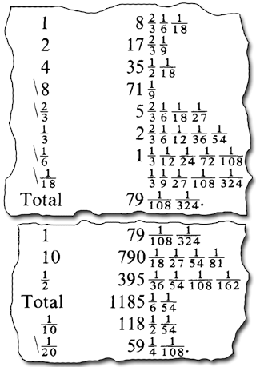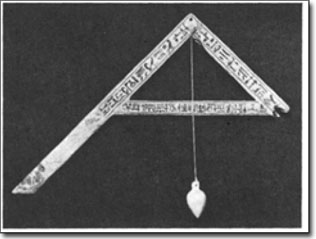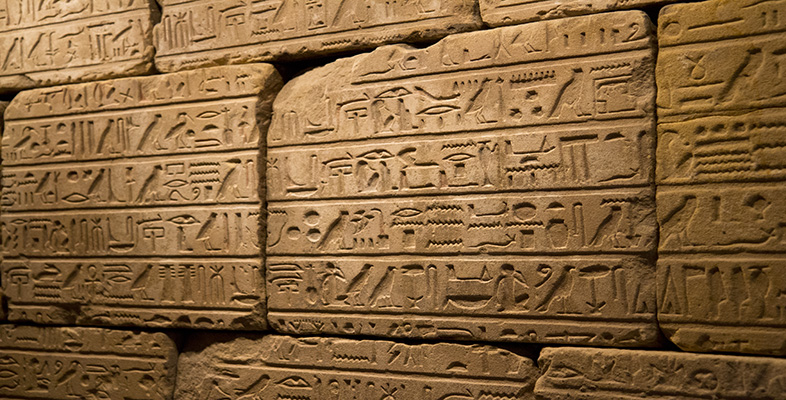1.1.3 More information about the Rhind papyrus
Box 4
Arnold Buffum Chace on Egyptian mathematics as pure science
A careful study of the Rhind papyrus convinced me several years ago that this work is not a mere selection of practical problems especially useful to determine land values, and that the Egyptians were not a nation of shopkeepers, interested only in that which they could use. Rather I believe that they studied mathematics and other subjects for their own sakes. In the Rhind papyrus there are problems of area and problems of volume that might be of use to the farmer who owns land and raises grain. There are pyramid problems that might furnish specifications to the builders, or enable an interested observer to determine the dimensions of a pyramid before him. Many of the arithmetical problems concern a division of loaves or of a quantity of grain among a certain number of men, or the relative values of different amounts of food or drink. But when we come to examine the conditions laid down and the numbers involved in these various problems as well as the purely numerical ones, we see that they are more like theoretical problems put in concrete form. In one (Problem 63) 700 loaves are divided among four men in shares that are proportional to the four fractions 2/3, 1/2, 1/3 and 1/4, the first four terms of their fraction-series. In two (Problems 40 and 64) there is a dividing into shares that form an arithmetical progression, in Problem 67 the tribute for cattle is determined as 1/61/18 of the herd and the problem asks for the number of the herd when the number of tribute cattle is given, and Problem 31 is a problem whose answer is
14 1/41/561/971/1941/3881/1691/776.
Such problems and such quantities were not likely to occur in the daily life of the Egyptians. Thus we can say that the Rhind papyrus, while very useful to the Egyptian, was also ‘an example of the cultivation of mathematics as a pure science, even in its first beginnings’ [H. Wieleitner, ‘Zur ägyptischen Mathematik’, Zeitschrift für mathematischen und naturwissenschaftlichen Unterricht, 56 (1925) pp. 129–137].
G. J. Toomer on Egyptian mathematics as strictly practical
The Rhind and Moscow papyri are handbooks for the scribe, giving model examples of how to do things which were a part of his everyday tasks. This is confirmed, if confirmation were needed, by a papyrus in the form of a satirical letter in which a scribe ridicules a colleague for his inability to do his job, and cites among other examples of his failures calculations of the rations of soldiers and of the number of bricks required for building a ramp of given dimensions. A further indication of the origin of these texts is the kind of expression used to introduce problems, for instance: ‘If a scribe says to you …, let him hear …’. The texts are in one respect similar to the Babylonian mathematical texts, in that these too are in the form not of treatises but of specific problems with solutions. But there the similarity ends: the cuneiform texts have a claim to be called mathematical in a fully scientific sense. The problems are only formally about the measurement of areas, determination of lengths, etc. Many of them are not of a kind which could conceivably ever occur in actual mensuration, and the whole point of them is the algebraic procedure involved. They are really ‘pure’ mathematics. However, this difference from the Egyptian texts is not the important one; mathematics can be applied to practical ends without losing any of its scientific quality. What really distinguishes Babylonian mathematics is the systematic development of intricate algebraic techniques which we can deduce from the working of the problems. These techniques could never have been created by mere empiricism, and we must posit an order of mathematical reasoning of which there is no trace in the Egyptian sources.
To illustrate the elementary and practical nature of Egyptian mathematics, we set out Problem 42 of the Rhind papyrus in full below.
Problem 42
Find the volume of a cylindrical granary of diameter 10 and height 10.
Take away 1/9 of 10, namely 1 1/9 the remainder is 8 2/31/61/18 . Multiply 8 2/31/61/18 times 8 2/31/61/18; it makes 79 1/1081/324. Multiply 79 1/1081/324 times 10; it makes 790 1/181/271/541/81 cubed cubits. Add 1/2 of it to it; it makes 1185 1/61/54, its contents in khar. 1/20 of this is 59 1/41/108. 59 1/41/108 times 100 hekat of grain will go into it.
Method of working out:

The problem is to determine the cubic content of a cylinder of diameter (D) 10 cubits and height (h) 10 cubits. This is complicated by the fact that for the Egyptian cubic content means how much it will hold of some specific thing, so an answer in cubic cubits is not satisfactory. It is therefore necessary to convert to hundreds of quadruple-hekat of corn by way of the equivalences:
1 cubic cubit = 11/2khar.
1 khar = 20 hundreds of quadruple-hekat.
In the working, some of the steps, which would require the use of auxiliary fractions, have certainly been omitted. But what is set down is enough to show that the real difficulty for the Egyptian scribe was the mastering of elementary arithmetical calculations; we can see how hemmed in he was by his numerical system, his crude methods, and his concrete mode of thought.
The truth is that Egyptian mathematics remained at much too low a level to be able to contribute anything of value. The sheer difficulties of calculation with such a crude numeral system and primitive methods effectively prevented any advance or interest in developing the science for its own sake. It served the needs of everyday life (it is only a relatively advanced technology, such as was never achieved in the ancient world, which demands more than the most elementary mathematics), and that was enough. Its interest for us lies in its primitive character, and in what it reveals about the minds of its creators and users, rather than in its historical influence.
Question 6
Do you now feel able lo form a view on which, if either, of these judgements on Egyptian mathematics is the better justified?
Discussion
My answer is ‘yes’ — I can now see better on what grounds the historians were putting forward their views, which helps me to decide which, if either, is preferable. In fact, I think neither can be endorsed wholeheartedly.
Chace's argument seems flawed by the point made in the previous Comment (Question 5), that unrealistic problems and answers do not in themselves imply a study of mathematics ‘for its own sake’,
Toomer's argument is difficult because he is making his judgement of Egyptian mathematics partly by means of a comparison with the Babylonians. Indeed, he seems engaged in a broader question than Chace does, one more to do with assessing how much the Egyptians contributed to the development or advance of mathematics, (This difference in the questions addressed by the two historians may go some way towards accounting for the difference in their conclusions.) It is also hard to separate out the validity of Toomer's judgement from the vigour of his language: ‘mere empiricism’, ‘hemmed in’, ‘crude methods’, ‘crude numeral system’, ‘primitive methods’, ‘primitive character’, leave us in no doubt about his feelings, certainly. In fact, Toomer's rhetoric is curiously stronger than that needed to make his point that the Egyptian influence on other cultures was not great. That might well be agreed independently of whether or not the Egyptians studied mathematics ‘for its own sake’.
What this exercise has also shown is that the endeavour to understand past mathematics naturally leads to forming judgements about it, in much the same way as art history and criticism are cognate activities. There is a disappointment in the reaction of some historians that a civilisation favoured by the gods in so many ways did not contribute more advanced mathematics. There was perhaps no need for more sophisticated mathematical investigation, nor any perception of such a possibility. As the historian Otto Neugebaucr has agreeably remarked:
Of all the civilisations of antiquity, the Egyptian seems to me to have been the most pleasant. The excellent protection which desert and sea provide for the Nile valley prevented the excessive development of the spirit of heroism which must often have made life in Greece hell on earth.
The Exact Sciences in Antiquity (Dover, 1969) p. 71.

